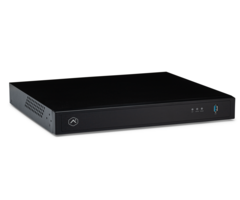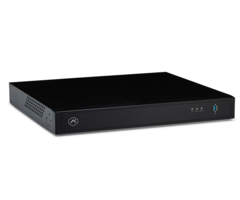An Introduction to PoE (Power over Ethernet)
Posted By Julia RossPower over Ethernet, also known as PoE allows power to be sent to a device using the same ethernet wire and RJ45 connector that is used for the network connection. Originally designed with VoIP phones in mind, PoE has quickly become a desirable option for IP cameras and other networked equipment.
Before we talk about PoE, we should discuss network cabling. Category 5 (Cat5), Category 5e (Cat5e), and Category 6 (Cat6) cables all consist of four (4) twisted pairs of wire, or a total of eight (8) conductors. The differences between these various categories of cable have to do with their ability to transfer data, over what distance, and at what speed. Generally, Cat6 is faster than Cat5 or Cat5e, and is less prone to crosstalk or noise issues.
The main point we want to make about network cabling, though, is this: With eight (8) conductors, any device that connects to a network using one of these cables, without using PoE, is wasting a number of wires. In fact, there are now cheaper cables out there that only have four (4) conductors, rather than the full eight (8). So, that brings us to two points. It makes sense that PoE has come into existence, and if you're preparing to use PoE devices, be sure you run cabling that will handle both data and power.
In PoE, there are a number of abbreviations commonly used:
| Abbreviation | Meaning | Description |
|---|---|---|
| PD | Powered Device | Any networked device receiving PoE |
| PSE | Power Sourcing Equipment | Devices that send both power and data over Ethernet cable to a PD. Referred to as either "Midspan" or "Endspan". |
| Endspan or Endpoint | A typical example of this is a PoE network switch. It provides power to Powered Devices (PD). | |
| Midspan | If a switch is used that doesn't provide PoE power, then a power source will need to be added between the switch and the PD. A common example is a PoE Injector. This is considered a Midspan PSE device. |
The benefits of PoE are numerous, as you can imagine. Rather than having every camera in an installation require the use of an outlet, a PoE switch using a single outlet can provide both power and Ethernet to a multitude of cameras with a single Cat5 or Cat6 wire going to each. In many cases, Ethernet cabling may already be installed, particularly in commercial installations, thereby lowering installation costs for PoE equipment. Another benefit is that when each powered device is receiving its power from a PoE capable switch, it is often possible to restart a PoE-powered device remotely, without having to go to the device itself.
The IEEE 802.3 standard governs PoE Switches and PoE Injectors. There is no special cabling required with the exception that the standard called Ultra-PoE uses all eight (8) pins of the RJ45 connector, so this would be one instance where a cheaper 4-pin cable would not work.
The table below shows the IEEE 802.3 standards and their requirements:
| PoE Standard | Minimum Cable Required | Pins Required | Supported Modes |
|---|---|---|---|
| IEEE 802.3af | Cat5 | 4-pins or 2 Pairs | Mode A, Mode B |
| IEEE 802.3at | Cat5 | 4-pins or 2 Pairs | Mode A, Mode B |
| IEEE 802.3bt Type 3 | Cat5 | 8-pins or 4 Pairs | 4-pair |
| IEEE 802.3bt Type 4 | Cat5 | 8-pins or 4 Pairs | 4-pair |
There is a type of cable called CCA or Copper Clad Aluminum. Although this cable is fine for networking, it is not suitable for use with PoE. This is due to the aluminum core. Aluminum doesn't conduct as well as copper and has a higher DC resistance. This causes it to lose more power over distance and to get hotter. When working with PoE, stick with 100% copper cabling.
One of the things you may find difficult about using PoE is figuring out if you have enough power from the PSE for a PoE device. These specs are usually listed in Watts, rather than in the available current, which can further complicate things. Here, knowing which standard each device uses is most helpful.
Below, see the various PoE standards, and the power both supplied and required for each:
| PoE Standard | Voltage @ PD | Voltage @ PSE | Minimum Power for PD | Minimum Output @ PSE | Maximum Cable Length |
|---|---|---|---|---|---|
| IEEE 802.3af | 37-57 V | 44-57 V | 12.95 W or 350 mA | 15.40 W | 100 m |
| IEEE 802.3at | 42.5-57 V | 50-57 V | 25.5 W | 30 W | 100 m |
| IEEE 802.3bt Type 3 | 42.5-57 V | 50-57 V | 51 W | 60 W | 100 m |
| IEEE 802.3bt Type 4 | 41.1-57 V | 52-57 V | 71 W | 100 W | 100 m |
The variations in voltage and current at the PD (Powered Device) in the table above have to do with the length of the cable run. The longer the cable, the more power is lost. You may have noticed in the above table that the maximum cable length for each PoE Standard is 100 m (328'). This is actually a limitation of both Cat5 and Cat6 cables, as the maximum length of a single run for either type of cable is 100m. The minimum voltage and available power listed above assume a cable run of the maximum length.
So then, what if you need to run a cable further than 100m? For PoE devices, you would add a PoE extender. Specifications may vary, but usually, each PoE extender can add another 100 m of cable length between the PSE and the PD. Usually, each PoE extender is only good for a single PD. Not all PoE extenders are the same, though, and some may not support daisy-chaining, while others do. Check out the specifications of any PoE extender you choose to use if you find yourself in a position to need longer cable runs.



